Contributory members are able to log private notes and comments about each site
Sites theCAptain has logged. View this log as a table or view the most recent logs from everyone
Minions Platform Round Barrow
Date Added: 18th Sep 2010
Site Type: Cairn
Country: England (Cornwall)
Visited: Yes on 22nd Oct 2009
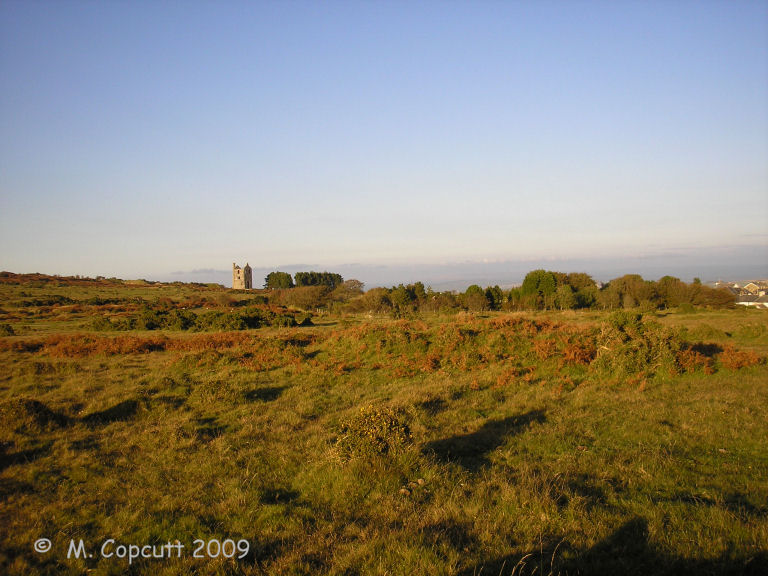
Minions Platform Round Barrow submitted by thecaptain on 22nd Oct 2009. The platform cairn marked on OS Maps as "Minions Mound".
In reality it is not the round barrow of that name which gave its name to the village, which was previously known as "Cheesewring Railway".
(View photo, vote or add a comment)
Log Text: None
Tregarrick Tor hillfort
Date Added: 18th Sep 2010
Site Type: Hillfort
Country: England (Cornwall)
Visited: Yes on 21st Oct 2009

Tregarrick Tor hillfort submitted by thecaptain on 21st Oct 2009. View northeast from Tregarrick Tor, across Craddock Moor to Stowe's Pound.
Many of the huts etc of the enclosed settlement can be seen in the foreground.
(View photo, vote or add a comment)
Log Text: None
Tregarrick Tor cairn
Date Added: 18th Sep 2010
Site Type: Chambered Cairn
Country: England (Cornwall)
Visited: Yes on 21st Oct 2009

Tregarrick Tor cairn submitted by thecaptain on 21st Oct 2009. The southern outcrop of Tregarrick Tor, with its "tor cairn" built up to it on the right hand slopes, and also the strange stone setting type arrangement in the foreground.
Is it part of a cairn internal structure or perhaps a separate stone setting of some kind.
(View photo, vote or add a comment)
Log Text: None
Craddock Moor embanked avenue
Date Added: 18th Sep 2010
Site Type: Misc. Earthwork
Country: England (Cornwall)
Visited: Yes on 7th Oct 2009
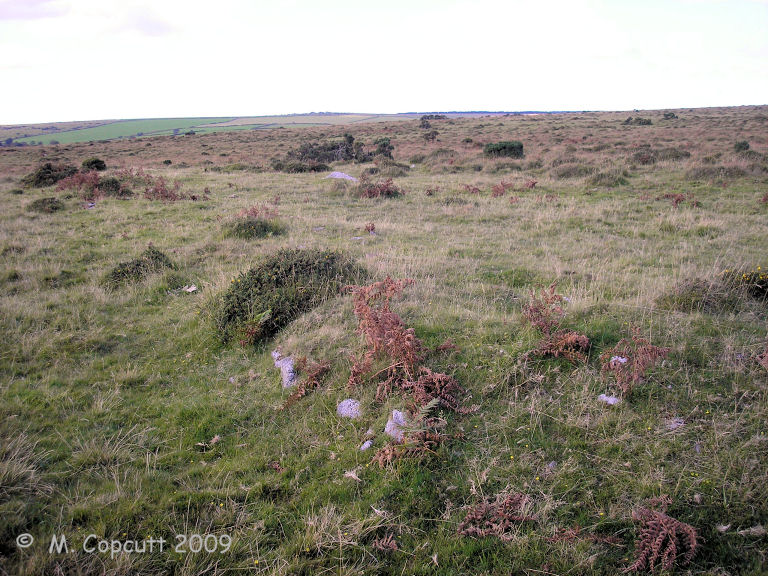
Craddock Moor embanked avenue submitted by thecaptain on 7th Oct 2009. The banks are still about half a metre to a metre in height, and in places seem to have got some stone slabs along the inner edges, perhaps once making a sort of kerb.
(View photo, vote or add a comment)
Log Text: None
Stowe's Pound
Date Added: 18th Sep 2010
Site Type: Ancient Village or Settlement
Country: England (Cornwall)
Visited: Yes on 2nd Oct 2009
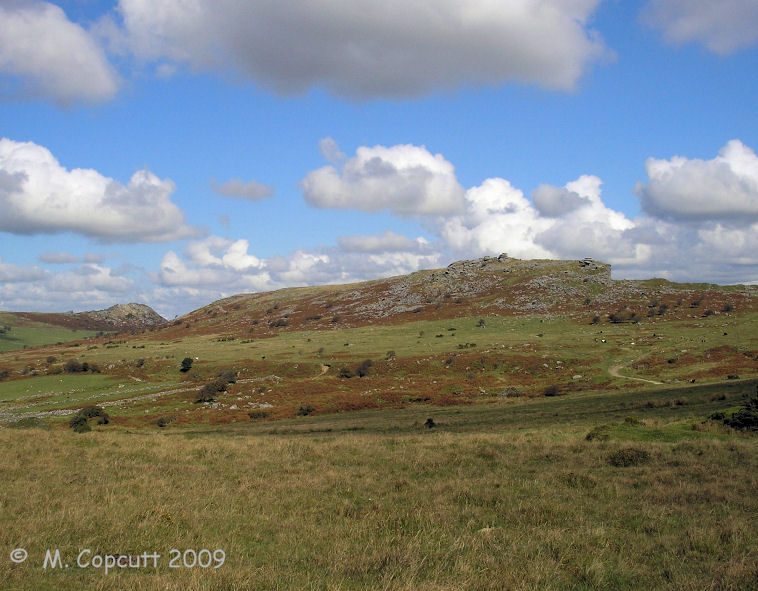
Stowe's Pound submitted by thecaptain on 2nd Oct 2009. Stowe's Pound, with its two neolithic hilltop enclosures, plus settlement with its many hut circles and field systems.
Seen here looking east from Craddock Moor.
(View photo, vote or add a comment)
Log Text: None
Craddock Moor platform cairn
Date Added: 18th Sep 2010
Site Type: Cairn
Country: England (Cornwall)
Visited: Yes on 1st Oct 2009
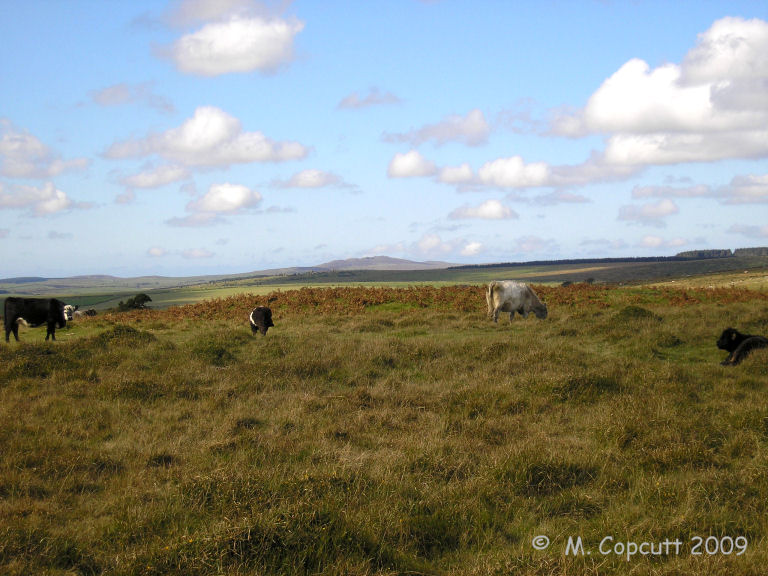
Craddock Moor platform cairn submitted by thecaptain on 1st Oct 2009. View northeast over Craddock Moor platform cairn, and right across the middle of Bodmin Moor.
Cornwall's very own mountain Brown Willy is in the distance.
(View photo, vote or add a comment)
Log Text: None
Craddock Moor Stone Setting
Date Added: 18th Sep 2010
Site Type: Standing Stones
Country: England (Cornwall)
Visited: Yes on 30th Sep 2009
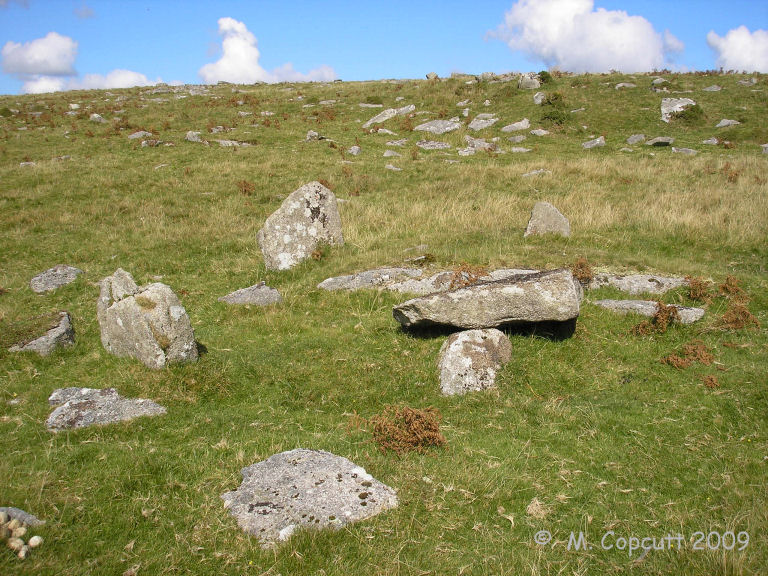
Craddock Moor Stone Setting submitted by thecaptain on 30th Sep 2009. On the rocky slopes to the southwest of Goldiggings Quarry, a small stone setting is to be found. The obvious stones which are first seen are three or four standing stones about half a metre tall making a sort of circle, with a slab lying on top of a further stone within it.
(View photo, vote or add a comment)
Log Text: None
Bearah Common Long Cairn
Date Added: 18th Sep 2010
Site Type: Chambered Cairn
Country: England (Cornwall)
Visited: Yes on 26th Sep 2009

Bearah Common Long Cairn submitted by thecaptain on 26th Sep 2009. Although the long cairn is right beside the trackway, it is difficult to see as you approach unless you are really looking !
(View photo, vote or add a comment)
Log Text: None
Craddock Moor circle
Date Added: 18th Sep 2010
Site Type: Stone Circle
Country: England (Cornwall)
Visited: Yes on 22nd Sep 2009
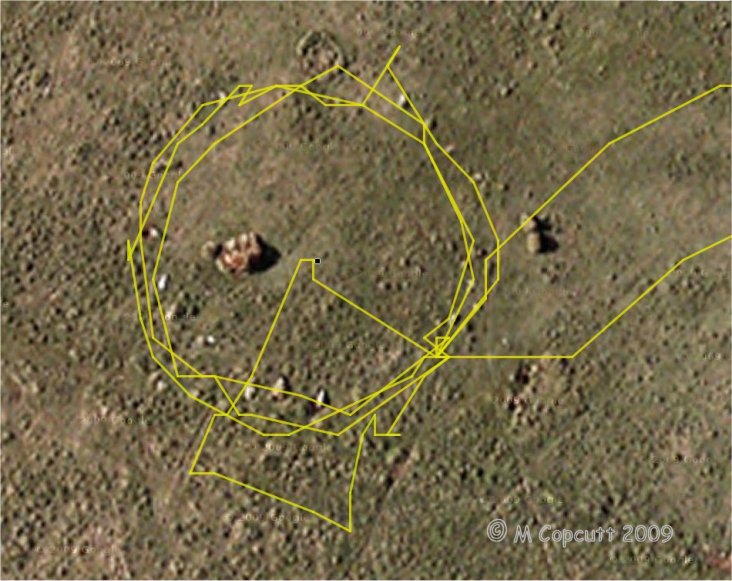
Craddock Moor circle submitted by thecaptain on 22nd Sep 2009. gps track plot of my wanderings round Craddock Moor stone circle on Sunday. Many of the stones can be seen in the picture.
I use an ageing Garmin etrex Venture pocket reciever, and the track is plotted out using GPSVisualizer, with only a few minutes fiddling.
I find it amazing the results that can now be obtained for things like this, using cheap, readily available technology, in a pocketsized device.
(View photo, vote or add a comment)
Log Text: None
Craddock Moor stone row
Date Added: 18th Sep 2010
Site Type: Stone Row / Alignment
Country: England (Cornwall)
Visited: Yes on 22nd Sep 2009

Craddock Moor stone row submitted by thecaptain on 22nd Sep 2009. gps track plot of my wanderings round Craddock Moor, along the embanked avenue and then the stone row on Sunday.
I use an ageing Garmin etrex Venture pocket reciever, and the track is plotted out using GPSVisualizer, with only a few minutes fiddling.
I find it amazing the results that can now be obtained for things like this, using cheap, readily available technology, in a pocketsized device.
(View photo, vote or add a comment)
Log Text: None
Furzehill Common Standing Stone
Date Added: 18th Sep 2010
Site Type: Standing Stone (Menhir)
Country: England (Devon)
Visited: Yes on 14th Sep 2009
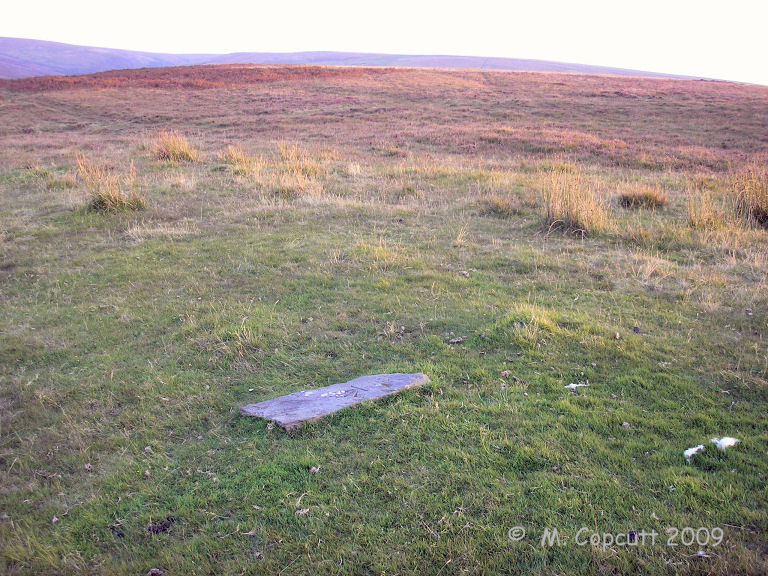
Furzehill Common Standing Stone submitted by thecaptain on 14th Sep 2009. The recently broken Furzehill Common standing stone, viewed here looking southwest over the common.
(View photo, vote or add a comment)
Log Text: None
Bristol City Museum
Date Added: 18th Sep 2010
Site Type: Museum
Country: England (Somerset)
Visited: Yes on 11th Aug 2009

Bristol City Museum submitted by thecaptain on 11th Aug 2009. As a part of the fabulous Banksy vs Bristol Museum exhibition this summer, a part of "Boghenge" (originally done at Glastonbury Festival in 2007) has been erected in the museum entrance.
(View photo, vote or add a comment)
Log Text: None
Beleven allée couverte
Trip No.209 Entry No.11 Date Added: 13th Jun 2020
Site Type: Passage Grave
Country: France (Bretagne:Côtes-D'Armor (22))
Visited: Yes on 12th Jun 2009. My rating: Condition 3 Ambience 2 Access 4

Beleven allée couverte submitted by thecaptain on 24th Jun 2009. There is even a sign here, but unfortunately while holding my camera above my head to get the picture, I have chopped off the bottom and left side a bit.
Still, it shows a plan and good artistic reconstruction of the place.
(View photo, vote or add a comment)
Log Text: Remains of a fairly disturbed but mostly complete allée couverte can be found in dark woodland to the northwest of the village of Plouer-sur-Rance, to the north of the magnificent ancient city of Dinan. Although the quartz block stones of this 14 metre long allée couverte are fairly well disturbed, it is in fact mostly complete, with a well defined terminal cella, and even with traces of its mound still to be seen. It is possible that it once had a lateral entrance.
Remarkably, it is stated that this monument was only discovered in 1972, which I find hard to believe, and it was classified as a monument historique as recently as 1981.
The poor thing is very close to a busy express highway, the N176, which runs along this northern edge of Brittany, but although the noise from the traffic is constant, the dense woodlands do a good job of hiding it all.
Despite looking on maps as if it would be very difficult to access, its on a wooded hillside right next to the dual carriageway road , there is in fact an emergency phone and layby nearby on the northbound carriageway, where it is possible to park and visit the monument. From the layby, hop over a little fence and follow a well worn path to the left for about 100 metres, and there it is ! Brilliant, its like the layby is deliberately put there for us stonehunters !
Outre Tombes
Trip No.209 Entry No.12 Date Added: 13th Jun 2020
Site Type: Stone Circle
Country: France (Bretagne:Ille-et-Vilaine (35))
Visited: Yes on 12th Jun 2009. My rating: Condition 3 Ambience 3 Access 5

Outre Tombes submitted by thecaptain on 5th Jul 2009. There are several information plaques at the site.
(View photo, vote or add a comment)
Log Text: This horseshoe of megalithic stones has alternatively been considered as a megalithic enclosure (cromlech) or perhaps the stones once surrounding a dolmenic burial chamber. Seven stones are shaped in a sort of semi circle, of diameter about 7 metres.
This monument was classified as a historical monument in 1966, but by 1977 had disappeared, being the victim of an expansion of the local quarry at Vaujour. When this was discovered, the police were called in, but it was all thought to be too late. However, in 1989 it was found that most of the stones hadn't simply been destroyed, but had been moved and dumped into a nearby field, although one had gone through the stonecrusher. With the help of a plan and photograph of the site taken in 1962, the local people (with the help of the quarrying company) had the site recreated in 1998, just a few hundred metres from its original position.
There is also a small menhir erected at the site, the origins of which I do not know, but the stone does not look modern. Today, the site sits in a little meadow near to the top of the quarry, and can be found beside the little road which runs along the top of the hills to the northeast of the massive Vaujour quarries. There are several information plaques at the site, telling of its history and with diagrams and pictures.
La Roche Longue (St-Marcan)
Trip No.209 Entry No.13 Date Added: 13th Jun 2020
Site Type: Standing Stone (Menhir)
Country: France (Bretagne:Ille-et-Vilaine (35))
Visited: Yes on 12th Jun 2009. My rating: Condition 4 Ambience 3 Access 4

La Roche Longue (St-Marcan) submitted by thecaptain on 30th Jun 2009. View of La Roche Longue seen from the west.
(View photo, vote or add a comment)
Log Text: This well shaped menhir is just under 3 metres tall in a field to the east of the St Marcan cemetary. As with my previous visit, the field is planted with maize, and is today sodden wet, which prevents me from being abole to walk right up to the stone. However, this time I can walk up the western edge of the field by the cemetary, and photograph its other side in the afternoon sunshine.
Menhir du Perron (St-Marcan)
Trip No.209 Entry No.14 Date Added: 13th Jun 2020
Site Type: Standing Stone (Menhir)
Country: France (Bretagne:Ille-et-Vilaine (35))
Visited: Yes on 12th Jun 2009. My rating: Condition -1
Log Text: A 2 metre tall menhir similar to the Roche Longue of St Marcan, once stood in the fields of Perron, about 800 metres south of La Roche Longue. It somehow disappeared in the 1930's.
Four-És-Feins
Trip No.209 Entry No.10 Date Added: 13th Jun 2020
Site Type: Passage Grave
Country: France (Bretagne:Ille-et-Vilaine (35))
Visited: Yes on 12th Jun 2009. My rating: Condition 2 Ambience 4 Access 3
Four-És-Feins submitted by karolus on 12th Jan 2018. Site in Bretagne:Ille-et-Vilaine (35) France
(View photo, vote or add a comment)
Log Text: I went and had another look for this while in the area last weekend, now knowing to look nearby to the Beillac farm. I could see nothing obvious when driving slowly down the lane past the farm, but there was an old couple out tending their wonderful vegetable garden, so I stopped and asked them if they could tell me where the dolmen was. They were interested to know what an Englishman was doing looking for the remnants of the dolmen, but were happy to help.
Unfortunately, I struggled to understand fully all they were saying, a combination of strong accent and using some words I just could not figure out. But I thought I had got enough of a lead to find it easily. Park out of the way of the farm track by the corner of the farm. Cross the field to the south on the newly cut hay at the edge of the field for 200 metres until reaching the other side. Go straight on about another 100 metres (unknown words) until I get to the big trees, and it is on the left, (some more unknown words). Put boots on if you have them. Sounds simple.
Well, it was all very simple simple, until I tried to decide which of all the woodlands were the correct big trees. However, after a few false starts, I found a place in a woodland to the left of the track, with a mound in it, and what looked to be some lumps sticking up, but it was very overgrown. It has to be this, surely. Closer inspection amongst the ivy and brambles, and there were clearly a few side set slabs sticking up through the ground, and I was pretty sure I could determine two rows of slabs about 1.5 metres apart from each other, but with no stone more than 0.5 metres tall, and most substantially lower. I reckoned that what I had found on top of the mound was about 10 metres in length, and had to be the remains of a very ruined allée couverte.
However, walking back to the car, I thought that these poor remains were not really enough to be known by the name Four-es-Feins; the Fairies Oven. Surely something with a name like that must be a grander structure. I also thought it to be too ruined to be what the old couple were explaining to me, although they did say it was just the remains of an allée couverte. I would have thought they would have told me not to bother rather than gladly give me directions.....
Upon returning to the car, I remembered I had book with description in a box in the boot. "Rectangular chamber measuring 10m by 1.5m with 6 orthostats on the south side and 5 on the north. Their length is between 1 and 1.8 metres, height about half a metre and thickness 0.3 metres. Brilliant, this all fits to what I saw. But then, the description goes on. Three cover slabs about half a metre thick, and the backstone are still in place. Around the monument, a dozen or so other stones lie scattered.
Well, I can believe the stones are now more covered by undergrowth and soil than that description, and hence seem smaller. The size, orientation and almost everything seems right, with one major exception; the three cover stones. There was nothing at all which could have been them. Read the description again and realise it has been based upon a plan and writings from 1886 and 1928. Maybe it has become much more wrecked since then, but what of the old couples talk ?
So, was this Four-es-Feins or not? If it wasn't, what had I found ? I am not sure, but like to think I did find it. Certainly until anyone proves otherwise and can show me something better I'll count it.
Puerco Pueblo.
Date Added: 18th Sep 2010
Site Type: Ancient Village or Settlement
Country: United States (The Southwest)
Visited: Yes on 28th May 2009

Puerco Pueblo. submitted by thecaptain on 28th May 2009. I believe these must be the Puerco Pueblo ancient ruins.
They are definitely somewhere in Petrified Forest national park, and the old photo is in my album on the same page as the petroglyph pictures!
(View photo, vote or add a comment)
Log Text: None
Agate House
Date Added: 18th Sep 2010
Site Type: Ancient Village or Settlement
Country: United States (The Southwest)
Visited: Yes on 28th May 2009
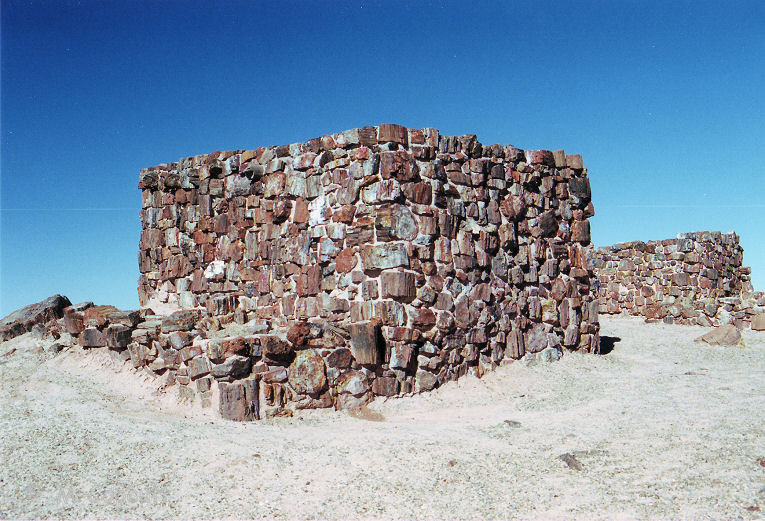
Agate House submitted by thecaptain on 28th May 2009. Agate House in Petrified Forest National Park.
picture from November 1990.
(View photo, vote or add a comment)
Log Text: None
Tuzigoot Monument
Date Added: 18th Sep 2010
Site Type: Ancient Village or Settlement
Country: United States (The Southwest)
Visited: Yes on 26th May 2009
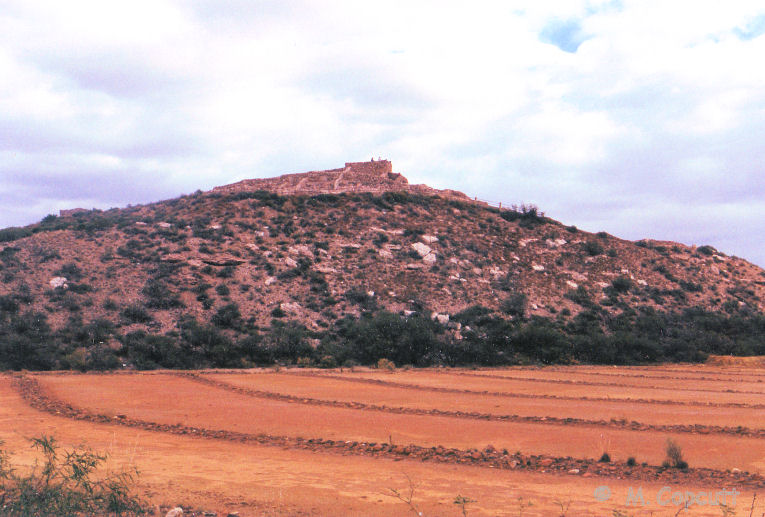
Tuzigoot Monument submitted by thecaptain on 26th May 2009. Tuzigoot Monument, pueblo built by the Sinagua culture.
Nov 1990.
(View photo, vote or add a comment)
Log Text: None
